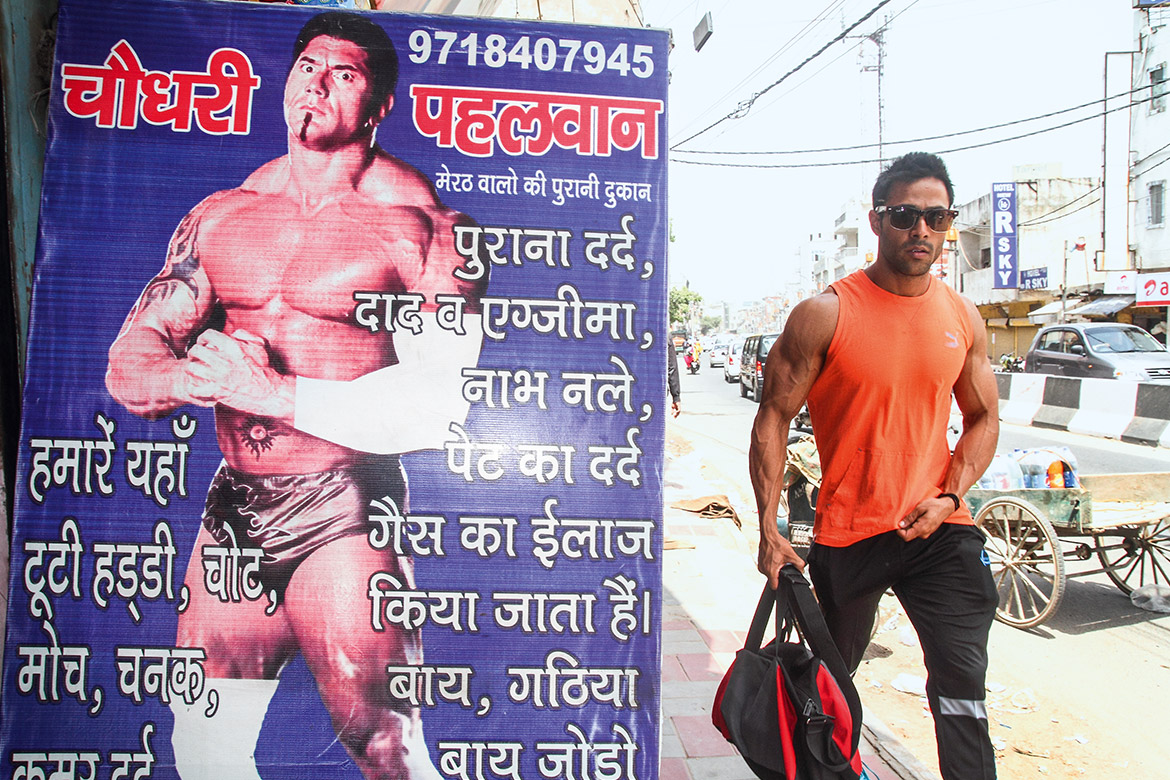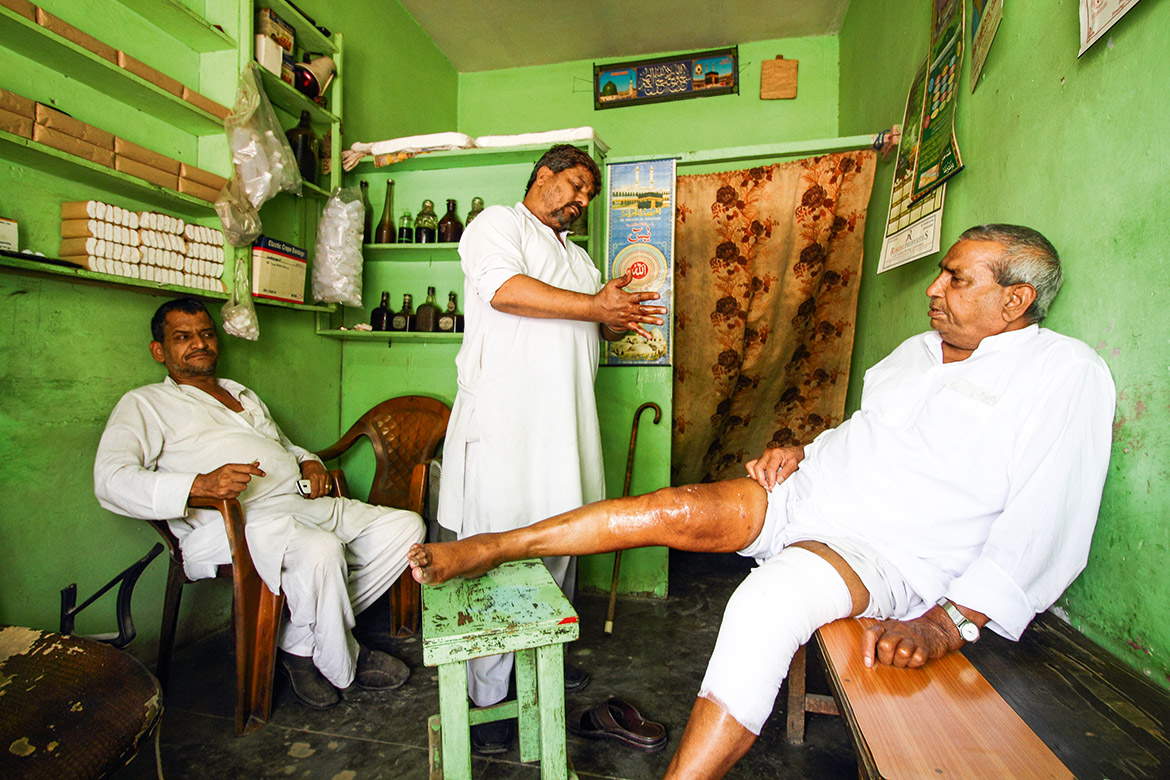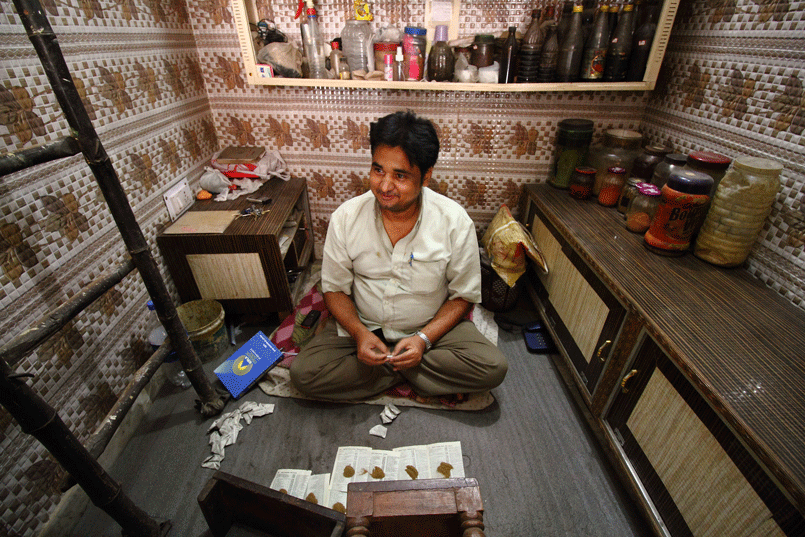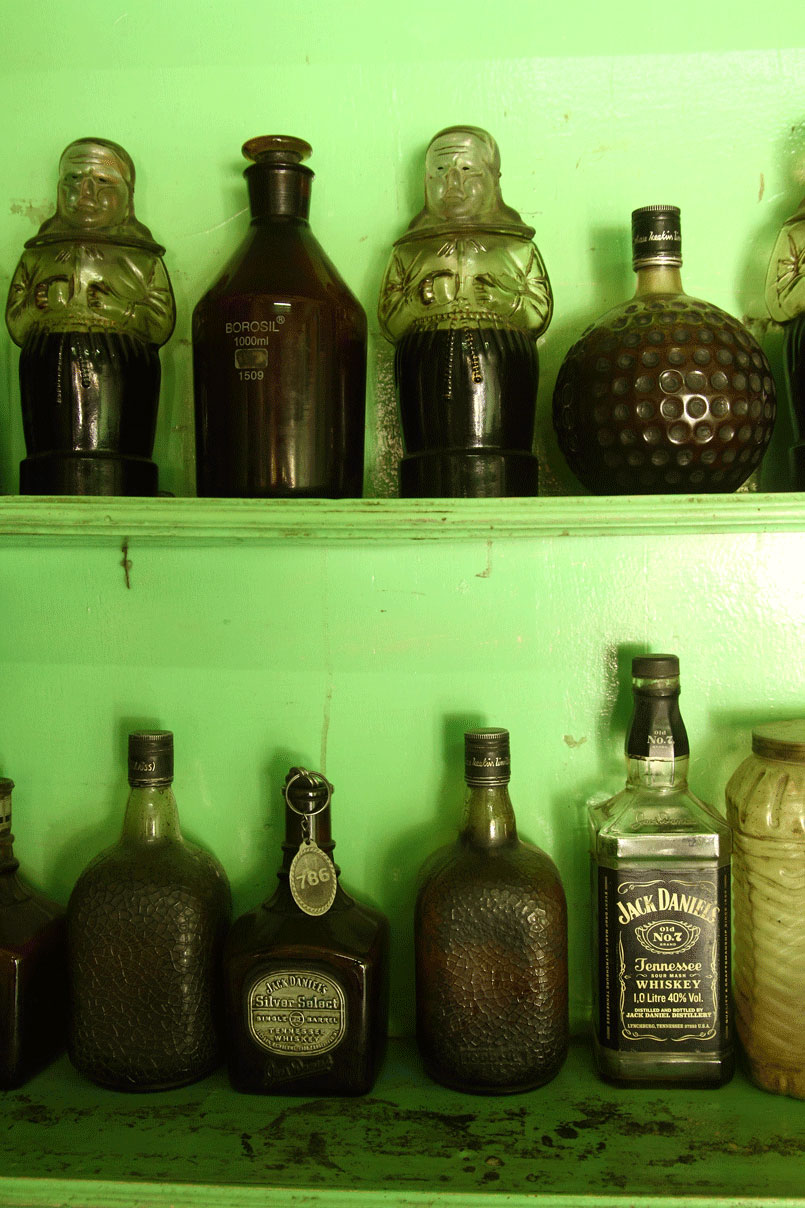
#Nurse
Byline: Aletta Andre
Photographs: Parikshit Rao
Teej Vaar (31) has been standing patiently in a narrow alley of East Delhi’s Shahdara neighbourhood for hours. Since 4am, to be precise. Twenty people were already patiently queued up before he, together with his 65 year-old mother, reached the short dead-ended gali, just off the area’s historical Chhota Bazar, a middle class area which dates from Mughal times. While the sun slowly rose and fruit and vegetable vendors started to open shop on the main road, the crowd expanded to dozens. At 7am the man they were all waiting for arrived, just like he does every day: Ghughi Pahelwan. Or rather, one of the three sons of the famous Lahori bonesetter who settled in Shahdara after Partition and set up shop here in 1954. He had learned the craft in Lahore from a guru, and passed on the shop to his sons who have been running it since his death in 1985.
A Noida security guard, Teej Vaar has learned one thing after three visits: in order to be seen by the hadvaid, one has to arrive early. Two visits to Ghughi Pahelwan’s shop have provided more relief to his mother, who has been suffering from pain in her left shoulder ever since it broke fifteen years ago, than multiple hospital visits able to provide, he claims.
‘Ghughi’’s reputation travels, as do the patients who come to see him. Naresh Kumar, a tailor with a broken shoulder, spent two hours in a bus from the Uttar Pradesh district of Rupnagar. “People there just know about it”, he says, when asked how he found his way to Shahdara.
A ten-minute walk from the metro station, every local we ask is able to give correct directions to the shop. When we arrive around 8am, three assistants to the bonesetter are managing the crowd, making all patients queue in a zigzag pattern all around the alley. Close to the main road, there are two rooms for accompanying relatives, and a strict eye is being kept on the exact position of those leaving the line to buy chai from one strategically located next-door stall. The assistants keep their other eye suspiciously on the visiting reporters. “No photos”, they say, before our camera is even out of the bag, and they keep repeating this instruction throughout our time in the alley.

Despite the lines that form in front of the Bonesetters of Shahdara, the traditional practice is an affront to many formally qualified doctors. Our interactions with patients are closely monitored by the assistants and quickly put to an end to after we ask a question about money. Naresh Kumar pays about Rs 100 to 150 per visit, a price he says is not fixed but depends on the patient.
Dressed all in white, the “doctor”, Satish Malhotra is of a slight build, and although he is 60 years old, he looks like he is still in his forties. He sits on the floor of the one-room shop halfway into the alley. Undisturbed, he massages a dark brown coloured ointment onto the hurt shoulder of a heavy man. After applying a disk-shaped piece of wood of about three inches in diameter on the shoulder, he wraps it in a fresh bandage. Malhotra speaks to us while he works, but won’t allow us to record the conversation.
The next patient is a young boy with a wooden splint attached to his broken underarm. Bone fractures are not an issue for him, says Malhotra, in a not particularly friendly tone. He can read X-rays, recognise different types of pain and strains and treat various fractures with splints and home-made ointments and medicine, all learned from his father. The recipes? Proprietary, but one hundred percent natural. Occasionally, he prescribes regular painkillers from neighbouring pharmacies. In the case of complicated fractures, he refers patients to the nearby GTB Hospital.
A large signboard above the shop shows the name Malhotra’s father was known by, while the old man himself looks over his son from a large colour portrait on the wall, honoured with a fresh garland. Surrounding him, dozens of black-and-white photos of wrestlers illustrate the bonesetter’s name and image – Pahelwan, the wrestler, a strong man.
Wrestlers are a recurring theme at bonesetter shops all over Delhi. Most have one painted onto the signboards at their door, together with a list of all the treatments on offer. Some are drawings of muscled men with old-fashioned moustaches, and others are pictures of WWF wrestlers from the United States. Like Ghughi, many bonesetters use the word Pahelwan in their shop name. Other shops in the neighbourhood have even adopted Ghughi as a kind of brand name, using it in various spellings.
A few minutes away Saleem, a wrestler, has run the shop Guru Guggu Pahelwan for the past dozen years. He also owns a nearby akhara that he inherited from his father, who brought his family to Delhi from Aligarh 35 years ago. Saleem’s two sons are wrestlers and compete in the sport, which, according to him, helps a lot in learning the skills of a bonesetter. “Wrestlers understand the human body,” he explains, while softly massaging the broken fingers of an elderly sari-clad woman with a hot poultice that is filled with, again, with a ‘secret’ substance. “They know about bones and muscles.”
The woman takes notes worth sixty rupees from her bra to pay Saleem, and asks him for a prescription. “The expensive or the cheap one?” he asks her. “The cheap one”, she says, after which he hands her a pre-printed piece of paper. It’s for a cheaper brand of painkillers from the pharmacy, he explains.
Despite the lines that form in front of the bonesetters of Shahdara, the traditional practice is an affront to many formally qualified doctors. “They should be put behind bars,” says doctor Anmol Maria, an orthopaedic surgeon and President of the Delhi Orthopedic Association. The danger, according to Maria, is that there is nothing to stop anyone from setting up shop. “No licence is required, no registration. The result is that the majority creates more complications, after which the patient comes to us.”
Maria explains that an ankle fracture, for example, is commonly mistaken for a sprain. Despite their claims, most bonesetters cannot read X-rays, he says, and would just massage such a fracture. “When the patient then comes to us three or four weeks later, the fracture is much more difficult to treat, and might result in chronic pain.”
It is indeed easy to set up shop as a bonesetter. In South Delhi’s Rangpuri village, close to the Indira Gandhi International Airport, 18 year-old Zahid Khan runs his own shop. He says he finished school up to 12th standard and trained for one year with his uncle, Ikram Khan, who runs a nearby shop. Zahid, too, claims he can treat all kinds of bone fractures and even make his own plaster cast around arms and legs, if necessary. Like Ghughi Pahelwan, Zahid admits he won’t treat complicated fractures. “For those, I send people to the hospital. I can help with easy fractures, sprains and boils.”
Asked why he thinks people come to see him at all, rather than going to the hospital immediately, irrespective of how complicated their fracture is, Zahid simply says: “The hospital is more expensive. There is no need to go there.” For a plaster Zahid charges up to Rs 2000, depending on its size. A simple check-up won’t cost more than 100 rupees. “But it depends on the patient. If he has less money, or wants to give more, it is also alright.”
Like most bonesetters, Zahid’s shop has several shelves lining the wall that are filled with his medicinal blends. Apart from some jars with regular kitchen spices there are empty Old Monk rum bottles filled with dark brown liquids. Zahid is less secretive than others about their contents: “Mustard oil and three to four plants I pluck in the jungle around my village.” His village is close to Ghaziabad. In this part of Delhi, most bonesetters use the name Chaudhari, rather than Ghughi, and Meerut as their city of reference.
Zahids uncle Ikram is not in town. Instead, his 16 year-old son Shavez Rana is receiving patients in his shop on Mahipalpur’s Mata Chowk. He has already learned how to make medicine and how to apply bandages, but acknowledges that he needs at least two more years of training to acquire his father’s set of skills. It is not Shavez’s ambition to become a full-time bonesetter, however. He is currently in school, in class 11, he wants to pursue higher education in an engineering college.
Further down the road, ‘Meerutwala’ Mohammed Arif finds the number of new kids on the block worrying. Arif says he alone really is from Meerut, and that he was the first bonesetter to set up shop on Mata Chowk about twelve years ago. “I have lost some patients to the new guys in recent years”, he admits. According to him, many of them are not as genuine as he is. “They say they can learn all skills in just a year or two, but this is impossible. You need to train at least five to six years.”
The rivalry is evident in Shahdara as well. About a ten minute walk away from Ghughi Pahelwan, Ashu Shirqy boasts of at least as much legacy as the Lahorewala. His shop is called Bakerewale Pahelwan, “because my grandfather used to organise goat fights in the area”. The 21 year-old claims his father’s grandfather opened shop as a bonesetter eighty years ago, even earlier than Ghughi Pahelwan. “We are both very old and good”, Ashu says. “It’s just that he is much cheaper, that’s why he has more patients”, he adds. “All the new guys,” Ashu says, “are just in it for the money. They are not real.”






Sitting in his clinic in New Friends Colony, Dr Maria blasts the government for not taking the “menace” seriously. “The government seems to lack the will to take action”, he says. “There is no fear of the law. And bonesetters are just one set of quacks.”
According to a 2006 report written by Darshan Shankar, Executive Director of the Foundation for Revitalization of Local Health Tradition and former Planning Commission advisor, bonesetters form one of the largest groups practicing traditional medicine. An exact number is not given, but the report states that bonesetters are only outnumbered by traditional midwifes, known as Dais. “There is roughly one bonesetter for every two to five villages in rural India.”
The Indian Medical Association (IMA), which has been lobbying for a strict ‘anti-quackery’ bill for years, estimates that there are in total a million unlicensed medical practitioners at work in India. Out of those, 600,000 have no official qualification at all, while about 4,00,000 practice allopathy despite being only qualified for one of the government-recognised alternative medicine streams. Known as a group as AYUSH, these accepted health systems are Ayurveda (ancient Hindu medicine), yoga (traditional Hindu philosophy of physical and mental discipline), siddha (traditional Tamil medicine), unani (traditional Eastern medicine with ancient Greek roots), naturopathy (19th century Europe, based on ideas of self-healing) and homeopathy (18th century Germany, based on idea that diseases can be cured with small portions of those same substances that cause symptoms of that disease). Most bonesetters are a clear case of quackery in the definition of the IMA. They practice what the IMA considers a form of allopathy and prescribe modern medicine without any formal qualification. Even if their skills derive from the Ayurvedic or unani traditions, they are usually not formally qualified to practice it. Although they openly admit to having learned their trade from relatives, they call themselves ‘doctor’ on their business cards. What’s more, some bonesetters offer additional services that seem to border on the magical. Ikram Khan, for example, claims that he can make people stop drinking alcohol without ever informing them.

Asked why he thinks people come to see him at all, Zahid simply says: ‘The hospital is more expensive. There is no need to go there.’ Not everyone agrees, however, whether bonesetters ought to be considered for formal qualification rather than jailed, as Dr Maria suggests. The Ministry Of Ayush, on its website, acknowledges that surgery is one form of treatment in the unani system. Several states, such as Maharashtra in 2014, have allowed Ayurvedic and unani doctors with a Master’s degree to practice allopathy and perform surgeries. And the Planning Commission, in a 2012 report, named bonesetting as one of the forms of healthcare knowledge of “around a million village-based, traditional AYUSH community health workers”, that could be considered for “accreditation and certification” to promote “the development of new drugs and therapies”.
One doctor who completely subscribes to this idea is Dr Amitabh Mitra, an India-born orthopaedic surgeon who now heads the trauma department of the Cecilia Makiwane Hospital in Mdantsane, South Africa. “Bonesetters should not be taken lightly”, he says. Dr. Mitra, who hails from Gwalior in MP, argues, “I’m sure they would not hamper their trade, which is built on their image, by trying to heal someone where they cannot. I have met many bonesetters in Gwalior and they were always very keen to know me and learn from me. I would sometimes call them in for help and similarly, if they came across complications they would contact me.”
Dr Mitra, who has passionately written about bonesetters on his own blog, says doctors should be proud of the legacy of bonesetters. He also admits no medical journal has been willing to publish his writings on the subject. He tells us about the 19th century Welsh doctor Hugh Owen Thomas, who is considered the father of modern orthopaedics. “His father and grandfather were bonesetters. This is part of our own heritage. This is as old as the city of Delhi.” Dr Mitra suspects that bonesetting might have arrived or been reintroduced in north India by the Mughals.
This is the tradition hakeem Abdul Naim, a practitioner of unani medicine from Old Delhi, sees himself in. He estimates that his forefathers started to practice in Delhi about a hundred years ago. “In the British time, we served the British government also”, he says, sitting in his practice close to Turkman Gate. He only treats joints – sprains and fractures – he says, all according to the unani medical tradition
Naim never prescribes modern medicine, he says. “Those can have side effects, such as a bad liver. My medicines are completely natural and have no side effects.” Now Naim’s son, 25 year-old Owais Khan, is about to become the first hakeem in the family with a formal degree: a BA in Unani Medicine. For Naim’s patients, however, his lack of a degree does not matter. One woman, Madhu, has travelled for about an hour to see Naim. “I first heard about this doctor from my neighbours more than fifteen years ago”, she says. “Me and my relatives have come here since.”
Madhu’s lower leg was broken four months ago and though it’s not in plaster anymore, it still hurts. She visits Naim twice a month for relief, and for the rest of the time he provides her with a stock of unani medicine to apply on the leg and to mix with water. “It gets better after every time I visit”, she says.
Dr Maria acknowledges that some bonesetters might have some genuine knowledge and skills, passed on from their forefathers, but finds it problematic that it is impossible to distinguish them from those who don’t. “There is no structure and no transparency. Also a simple strain or non-serious backache is likely to heal anyway, so if that happens after visiting a bonesetter the patient might recommend him to family and friends. If the ailment is more serious, however, and if anything goes wrong, than he is not accountable.”
The main reason behind the continuing popularity of the bonesetter, Dr Maria suspects, is not their skills but their low price. In addition, he says, in remote villages a bonesetter is often all that is available at an acceptable distance to patients.
The doctor-patient ration in India is low: there are only 0.7 doctors for every 1,000 people, according to the most recent World Bank data. In comparison, China has 1.9 per 1,000 inhabitants, the United Kingdom 2.8 and Cuba 6.7.
For the Maharashtra government, this was an important reason to allow Ayurvedic and unani doctors to practice allopathy as well. The medical education department reportedly argued that the move would improve the reach of medical service in rural areas.
In the capital city the availability of hospitals and orthopaedic surgeons might be less of an issue than in the rural interiors. Indeed, the GTB Hospital is just around the corner from where Ghughi Pahelwan sits. But most patients we speak to at bonesetters across town do mention that it is much cheaper to visit them compared to a hospital. In addition the bonesetters are easily approachable. With the exception of Ghughi Pahelwar in Shahdara, there are hardly any queues involved and there is no need for patients to register or bring any documents.

His father and grandfather were Bonesetters. This is part of our heritage. This is as old as the city of Delhi. But, as patients such as Teej Vaar, Naresh Kumar and Madhu show, there is more to it than that. Whether Ghughi Pahelwan and Abdul Naim have a special skill or whether their reputation stems from healing wounds that would have healed anyway and they are simply a cheap menace to society – their patients believe strongly in them and are willing to travel far for their chosen cure. Bonesetters remain not just a necessary and cheap alternative to the formal health care system, but that they are culturally relevant too.
As Jitendra Mohan, an advocate who came from Ghaziabad to have his back pain treated at Saleem’s shop Guru Guggu Pahelwan in Shahdara, explains, “Perhaps a local hospital could also help me. But I know this place, I have come here for years, and it works for me. So why change?”